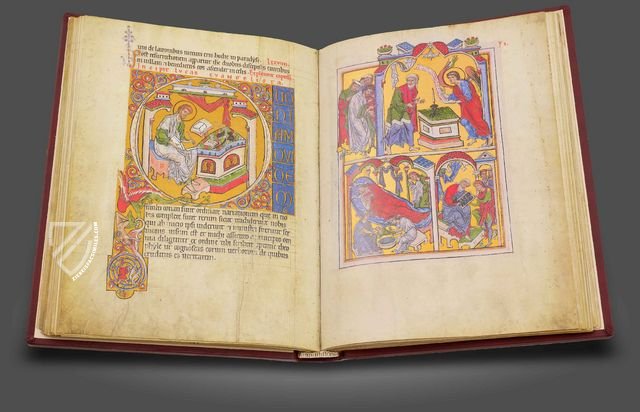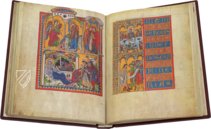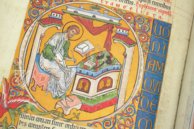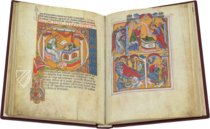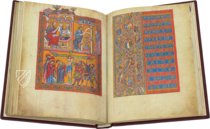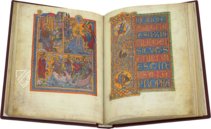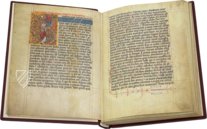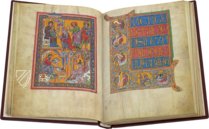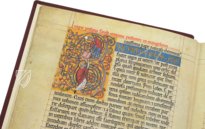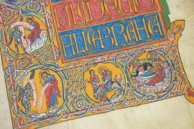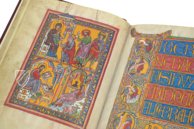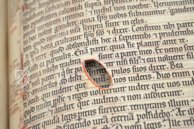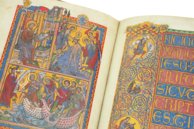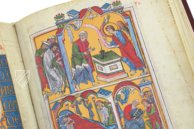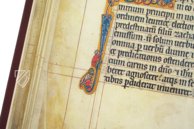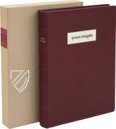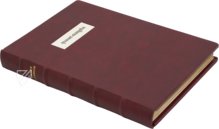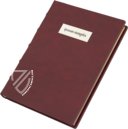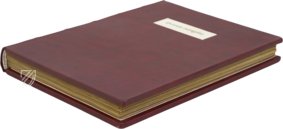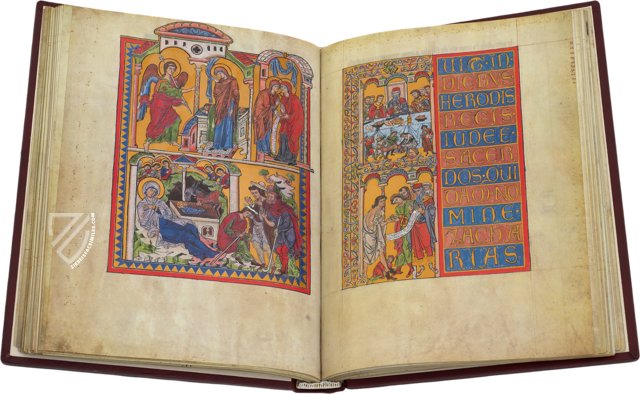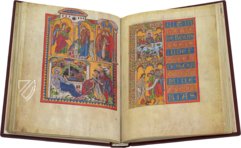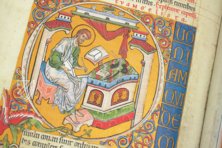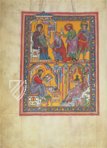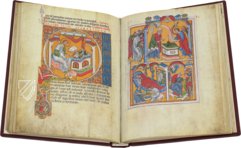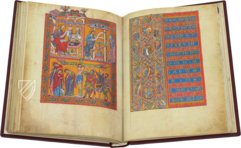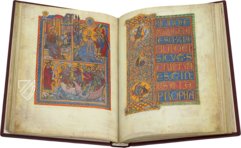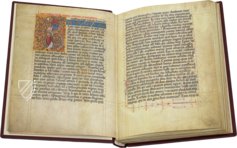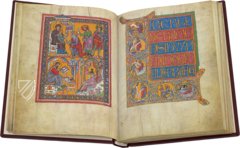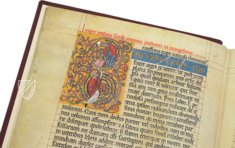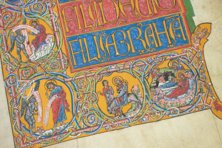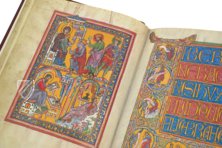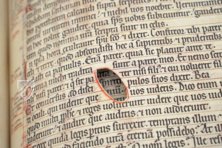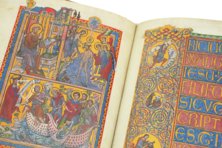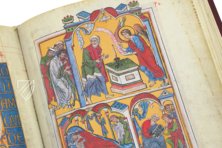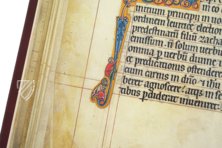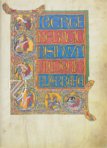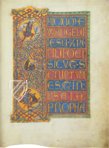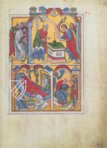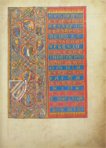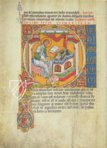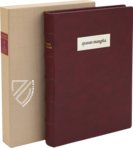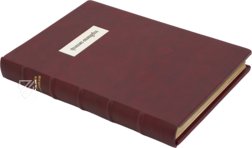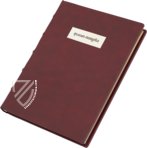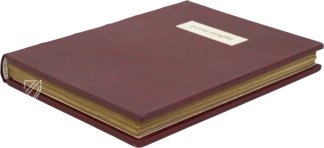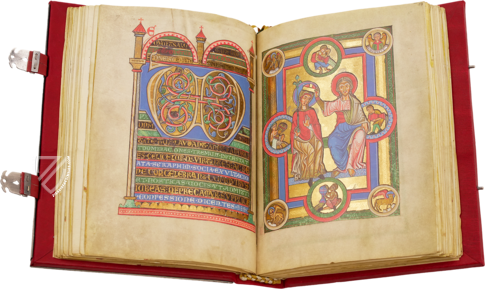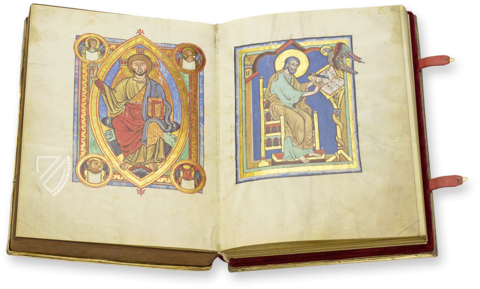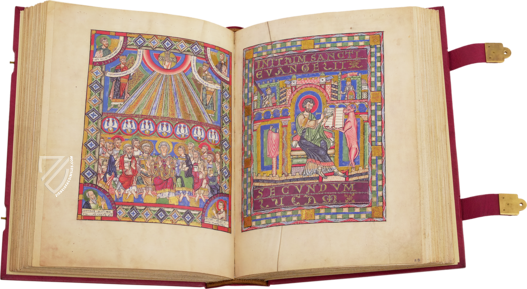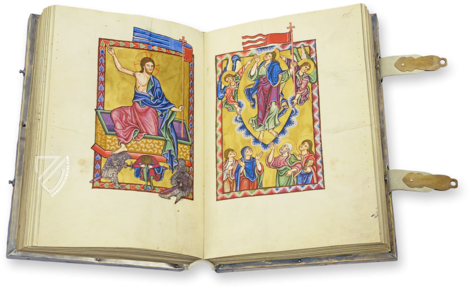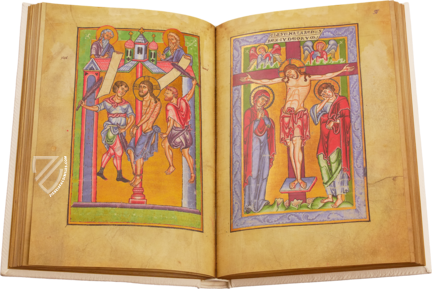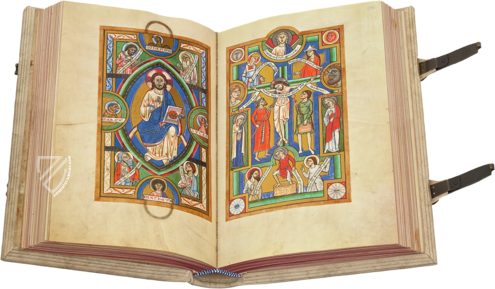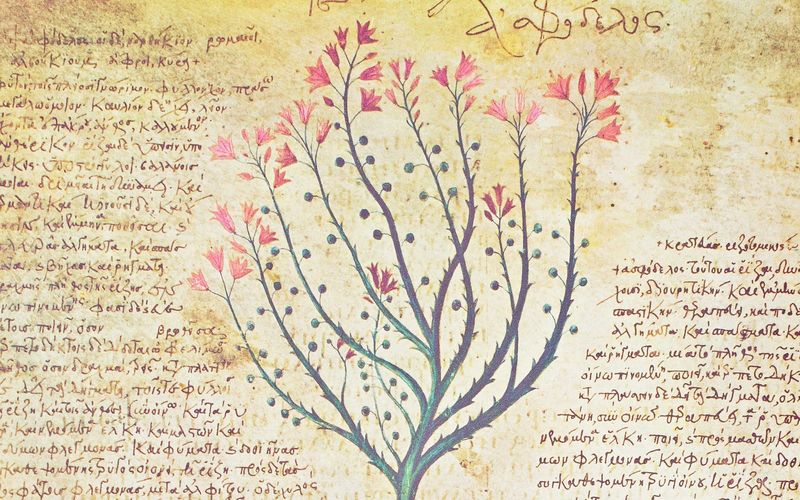Goslar Gospels
(1,000€ - 3,000€)
One of the most exquisite creations preserved to this day from the Staufer period: the Goslar Gospels. This is a large luxury manuscript intended for use in church and other public displays to the faithful. A full-page miniature prefixes each Gospel along with a full-page initial made to give the beholder an overall impression of the text that follows, but Saint Luke, to whom history attributes the highest credibility among all the Evangelists, was assigned an additional initial and miniature page. The manuscript has 30 full-page miniatures, which are typically divided into two or more scenes, and incipit pages as well as numerous golden initials. The text is a work of art in itself, the labor of a skilled scribe who executed the letters with an instantly discernible mastery. Altogether, this a splendid work of the early German Gothic style that is counted among the finest illuminated manuscript of the 13th centuries.
Goslar Gospels
The Goslar Gospels, so called after its probable place of origin in Lower Saxony, is one of the most exquisite creations preserved to this day from the Staufer period. Totaling 30 illustrations of biblical scenes, it was meant to instruct both educated and lay readers in the word of God. The book owes its importance to a very special production and combines different elements of the most diverse styles in a wonderful new harmony. The gospel book was predominantly used in church services where the word of salvation was read to believers. As Jesus Christ himself is present in the Gospels, a gospel book was given the utmost veneration in liturgy. Its open pages were offered to the faithful to be kissed and it was carried around town in processions. It can thus be assumed that this sumptuous work was not only accessible to a few privileged visitors of a library but that the entire community could admire it.
The Sacred Texts of Christendom
The structure of the codex is in line with the usual Gospel tradition. The prologue, which contains epistulas and a preface by Saint Jerome (among them a typology of the Gospels and an explanation of the symbols attributed to the four Evangelists), a letter of Saint Eusebius (on the origins of the harmony of the Gospels) and a prologue on the Gospels by an anonymous writer, is followed by the four gospel texts which are in turn each introduced by a table of contents (”capitula”) and a prologue (”argumentum”).
A showpiece of German Book Illumination
This sequence of texts and their inner structure also determines the decorative pattern of the Goslar Gospels. A full-page miniature prefixes each Gospel along with a full-page initial made to give the beholder an overall impression of the text that follows. Saint Luke, to whom history attributes the highest credibility among all the Evangelists, was assigned an additional initial and miniature page. The richly gold embellished miniature pages each display two or more scenic illustrations which, like the episodes inserted into the initial pages, are illustrations of the four Gospels. The imaginative and inventive decoration with initials lend the text pages of the gospel book a very special charm, the initials being ornate in a different manner, according to the function they fulfil. Some of them are decorated with colorful rançons and small inserted drolleries on a gilded ground, but there are also finely outlined initials filled with gold rançons, as well as golden letters on colored grounds, interlaced with fine scrollwork. The art of drawing and painting is practiced in a most sensitive manner throughout the Gospel, which thus belongs to the highest rank of illumination of its period.
A Beautiful and Fascinating Script
In addition to the precious quality of the pictures, which were meant to interpret the word of God for medieval believers, educated and laymen alike, the marvelous pages filled with script deserve the greatest attention. The scribe used a Gothic minuscule (textura), so typical of the first half of the 13th century, which he forms to a very beautiful script and wonderfully outbalanced letters. It must have been a very experienced copyist who wrote down the words of the Gospels with such great regularity, never negligent and with an ever-steady hand. When beholding the pages, one feels the great dignity of the medieval scribe to whom copying the word of God was in itself an act of worship.
The Binding
The facsimile edition is superbly bound in leather. The original manuscript, however, was protected in a binding of great artistic value, which has been preserved in its entirety up to this day, a very rare feature indeed. Although damaged in places and bearing the trace of time, it is still impressive with its fittings of gilded silver plate, with magnificent ornaments, embossing, filigree, precious stones (among them two antique gems), vitreous pastes and pearls. The upper plate shows a crucifixion scene in a Byzantine style, while the lower plate displays a silk embroidered Coronation of the Virgin. The topic illustrated on this plate leads us to assume that the adornment might have been the work of the nuns of Goslar Convent who wished to honor the Virgin Mary to whom their church was consecrated.
Codicology
- Alternative Titles
- Goslarer Evangeliar
Goslar Evangeliary - Size / Format
- 258 pages / 33.5 × 25.0 cm
- Origin
- Germany
- Date
- Ca. 1240
- Style
- Genre
- Language
- Script
- Gothic Textura Quadrata
- Illustrations
- 30 masterful full-page miniatures and incipit pages, numerous golden initials
- Content
- The Four Gospels with letters by St. Jerome, St. Eusebius, and others
- Patron
- Provost Johannes
Goslar Gospels
Incipit Page: Gospel of John
With a rich gold leaf background and strong primary colors, this is a fine specimen of German illumination spanning the Romanesque and Gothic styles. The elaborate column filled with scenes from the life of Christ as well as various drolleries serves as the “I” initial for the opening words of the Gospel of John: IN PRINCIPIO ERAT VERBVM ET VERBVM ERAT APVD DEVM ET DEVS ERAT VERBVM – “In the beginning was the Word, and the Word was with God, and the Word was God.” (Jhn. 1:1)
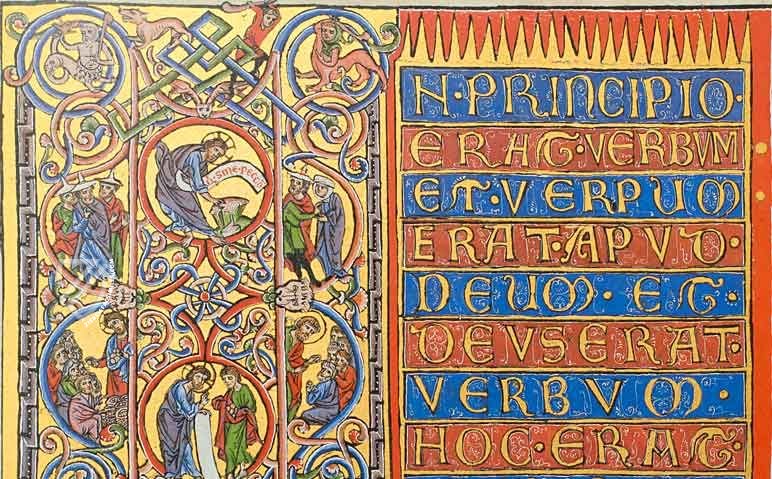
Goslar Gospels
Gospel of Mark
Each Gospel in this manuscript is prefaced by a full-page miniature combining an Evangelist portrait with two other scenes. In the top left we see Mark the Evangelist at his writing desk, to his right the baptism of Jesus, and below the commissioning of the Apostles. All three are backed by brilliantly burnished gold leaf, which further highlights the rich shades of red, blue, and green used by the artist.
The compositions are masterful, the figures are dressed in robes with a highly stylized, jagged fall of folds evocative of the emerging Zackenstil. There are also some curious details: hybrid creatures appear below the surface of the water in both biblical scenes. They represent the demons being left behind by the former pagans who are freed by baptism.
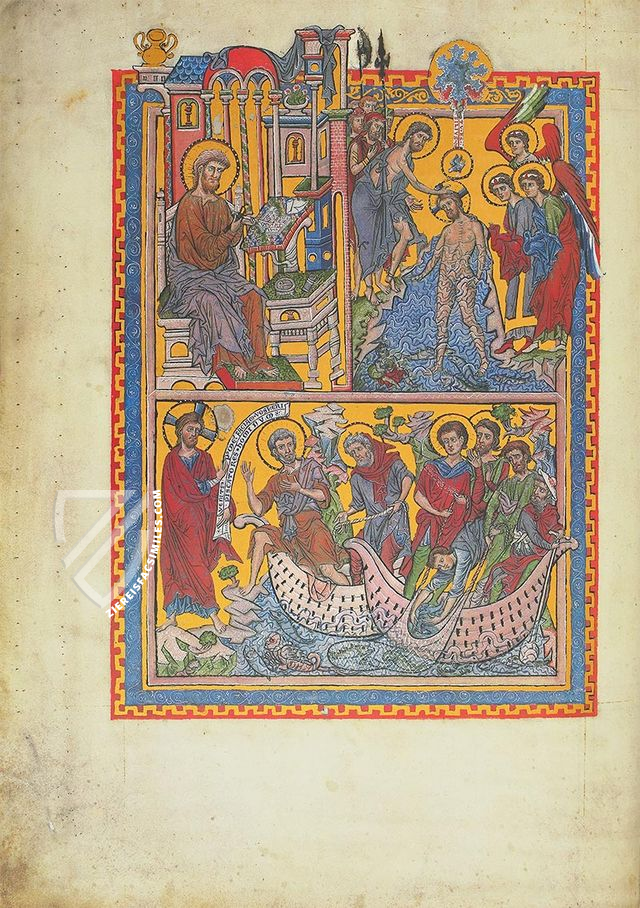
#1 Das Goslarer Evangeliar
Language: German
(1,000€ - 3,000€)
- Treatises / Secular Books
- Apocalypses / Beatus
- Astronomy / Astrology
- Bestiaries
- Bibles / Gospels
- Chronicles / History / Law
- Geography / Maps
- Saints' Lives
- Islam / Oriental
- Judaism / Hebrew
- Single Leaf Collections
- Leonardo da Vinci
- Literature / Poetry
- Liturgical Manuscripts
- Medicine / Botany / Alchemy
- Music
- Mythology / Prophecies
- Psalters
- Other Religious Books
- Games / Hunting
- Private Devotion Books
- Other Genres
- Afghanistan
- Armenia
- Austria
- Belgium
- Belize
- Bosnia and Herzegovina
- China
- Colombia
- Costa Rica
- Croatia
- Cyprus
- Czech Republic
- Denmark
- Egypt
- El Salvador
- Ethiopia
- France
- Germany
- Greece
- Guatemala
- Honduras
- Hungary
- India
- Iran
- Iraq
- Israel
- Italy
- Japan
- Jordan
- Kazakhstan
- Kyrgyzstan
- Lebanon
- Liechtenstein
- Luxembourg
- Mexico
- Morocco
- Netherlands
- Palestine
- Panama
- Peru
- Poland
- Portugal
- Romania
- Russia
- Serbia
- Spain
- Sri Lanka
- Sweden
- Switzerland
- Syria
- Tajikistan
- Turkey
- Turkmenistan
- Ukraine
- United Kingdom
- United States
- Uzbekistan
- Vatican City
- A. Oosthoek, van Holkema & Warendorf
- Aboca Museum
- Ajuntament de Valencia
- Akademie Verlag
- Akademische Druck- u. Verlagsanstalt (ADEVA)
- Aldo Ausilio Editore - Bottega d’Erasmo
- Alecto Historical Editions
- Alkuin Verlag
- Almqvist & Wiksell
- Amilcare Pizzi
- Andreas & Andreas Verlagsbuchhandlung
- Archa 90
- Archiv Verlag
- Archivi Edizioni
- Arnold Verlag
- ARS
- Ars Magna
- ArtCodex
- AyN Ediciones
- Azimuth Editions
- Badenia Verlag
- Bärenreiter-Verlag
- Belser Verlag
- Belser Verlag / WK Wertkontor
- Benziger Verlag
- Bernardinum Wydawnictwo
- BiblioGemma
- Biblioteca Apostolica Vaticana (Vaticanstadt, Vaticanstadt)
- Bibliotheca Palatina Faksimile Verlag
- Bibliotheca Rara
- Boydell & Brewer
- Bramante Edizioni
- Bredius Genootschap
- Brepols Publishers
- British Library
- C. Weckesser
- Caixa Catalunya
- Canesi
- CAPSA, Ars Scriptoria
- Caratzas Brothers, Publishers
- Carus Verlag
- Casamassima Libri
- Centrum Cartographie Verlag GmbH
- Chavane Verlag
- Christian Brandstätter Verlag
- Circulo Cientifico
- Club Bibliófilo Versol
- Club du Livre
- CM Editores
- Collegium Graphicum
- Collezione Apocrifa Da Vinci
- Comissão Nacional para as Comemorações dos Descobrimentos Portugueses
- Coron Verlag
- Corvina
- CTHS
- D. S. Brewer
- Damon
- De Agostini/UTET
- De Nederlandsche Boekhandel
- De Schutter
- Deuschle & Stemmle
- Deutscher Verlag für Kunstwissenschaft
- DIAMM
- Droz
- E. Schreiber Graphische Kunstanstalten
- Ediciones Boreal
- Ediciones Grial
- Ediclube
- Edições Inapa
- Edilan
- Editalia
- Edition Deuschle
- Edition Georg Popp
- Edition Leipzig
- Edition Libri Illustri
- Editiones Reales Sitios S. L.
- Éditions de l'Oiseau Lyre
- Editions Medicina Rara
- Editorial Casariego
- Editorial Mintzoa
- Editrice Antenore
- Editrice Velar
- Edizioni Edison
- Egeria, S.L.
- Eikon Editores
- Electa
- Emery Walker Limited
- Enciclopèdia Catalana
- Eos-Verlag
- Ephesus Publishing
- Ernst Battenberg
- Eugrammia Press
- Extraordinary Editions
- Fackelverlag
- Facsimila Art & Edition
- Facsimile Editions Ltd.
- Facsimilia Art & Edition Ebert KG
- Faksimile Verlag
- Feuermann Verlag
- Folger Shakespeare Library
- Franco Cosimo Panini Editore
- Friedrich Wittig Verlag
- Fundación Hullera Vasco-Leonesa
- G. Braziller
- Gabriele Mazzotta Editore
- Gebr. Mann Verlag
- Gesellschaft für graphische Industrie
- Getty Research Institute
- Giovanni Domenico de Rossi
- Giunti Editore
- Graffiti
- Grafica European Center of Fine Arts
- Guido Pressler
- Guillermo Blazquez
- Gustav Kiepenheuer
- H. N. Abrams
- Harrassowitz
- Harvard University Press
- Helikon
- Hendrickson Publishers
- Henning Oppermann
- Herder Verlag
- Hes & De Graaf Publishers
- Hoepli
- Holbein-Verlag
- Houghton Library
- Hugo Schmidt Verlag
- Idion Verlag
- Il Bulino, edizioni d'arte
- ILte
- Imago
- Insel Verlag
- Insel-Verlag Anton Kippenberger
- Instituto de Estudios Altoaragoneses
- Instituto Nacional de Antropología e Historia
- Istituto dell'Enciclopedia Italiana - Treccani
- Istituto Ellenico di Studi Bizantini e Postbizantini
- Istituto Geografico De Agostini
- Istituto Poligrafico e Zecca dello Stato
- Italarte Art Establishments
- Jan Thorbecke Verlag
- Johnson Reprint Corporation
- Josef Stocker
- Josef Stocker-Schmid
- Jugoslavija
- Karl W. Hiersemann
- Kasper Straube
- Kaydeda Ediciones
- Kindler Verlag / Coron Verlag
- Kodansha International Ltd.
- Konrad Kölbl Verlag
- Kurt Wolff Verlag
- La Liberia dello Stato
- La Linea Editrice
- La Meta Editore
- Lambert Schneider
- Landeskreditbank Baden-Württemberg
- Leo S. Olschki
- Les Incunables
- Liber Artis
- Library of Congress
- Libreria Musicale Italiana
- Lichtdruck
- Lito Immagine Editore
- Lumen Artis
- Lund Humphries
- M. Moleiro Editor
- Maison des Sciences de l'homme et de la société de Poitiers
- Manuscriptum
- Martinus Nijhoff
- Maruzen-Yushodo Co. Ltd.
- MASA
- Massada Publishers
- McGraw-Hill
- Metropolitan Museum of Art
- Militos
- Millennium Liber
- Müller & Schindler
- Nahar - Stavit
- Nahar and Steimatzky
- National Library of Wales
- Neri Pozza
- Nova Charta
- Oceanum Verlag
- Odeon
- Orbis Mediaevalis
- Orbis Pictus
- Österreichische Staatsdruckerei
- Oxford University Press
- Pageant Books
- Parzellers Buchverlag
- Patrimonio Ediciones
- Pattloch Verlag
- PIAF
- Pieper Verlag
- Plon-Nourrit et cie
- Poligrafiche Bolis
- Presses Universitaires de Strasbourg
- Prestel Verlag
- Princeton University Press
- Prisma Verlag
- Priuli & Verlucca, editori
- Pro Sport Verlag
- Propyläen Verlag
- Pytheas Books
- Quaternio Verlag Luzern
- Reales Sitios
- Recht-Verlag
- Reichert Verlag
- Reichsdruckerei
- Reprint Verlag
- Riehn & Reusch
- Roberto Vattori Editore
- Rosenkilde and Bagger
- Roxburghe Club
- Salerno Editrice
- Saltellus Press
- Sandoz
- Sarajevo Svjetlost
- Schöck ArtPrint Kft.
- Schulsinger Brothers
- Scolar Press
- Scrinium
- Scripta Maneant
- Scriptorium
- Shazar
- Siloé, arte y bibliofilia
- SISMEL - Edizioni del Galluzzo
- Sociedad Mexicana de Antropología
- Société des Bibliophiles & Iconophiles de Belgique
- Soncin Publishing
- Sorli Ediciones
- Stainer and Bell
- Studer
- Styria Verlag
- Sumptibus Pragopress
- Szegedi Tudomànyegyetem
- Taberna Libraria
- Tarshish Books
- Taschen
- Tempus Libri
- Testimonio Compañía Editorial
- Thames and Hudson
- The Clear Vue Publishing Partnership Limited
- The Facsimile Codex
- The Folio Society
- The Marquess of Normanby
- The Richard III and Yorkist History Trust
- Tip.Le.Co
- TouchArt
- TREC Publishing House
- TRI Publishing Co.
- Trident Editore
- Tuliba Collection
- Typis Regiae Officinae Polygraphicae
- Union Verlag Berlin
- Universidad de Granada
- University of California Press
- University of Chicago Press
- Urs Graf
- Vallecchi
- Van Wijnen
- VCH, Acta Humaniora
- VDI Verlag
- VEB Deutscher Verlag für Musik
- Verlag Anton Pustet / Andreas Verlag
- Verlag Bibliophile Drucke Josef Stocker
- Verlag der Münchner Drucke
- Verlag für Regionalgeschichte
- Verlag Styria
- Vicent Garcia Editores
- W. Turnowski Ltd.
- W. Turnowsky
- Waanders Printers
- Wiener Mechitharisten-Congregation (Wien, Österreich)
- Wissenschaftliche Buchgesellschaft
- Wissenschaftliche Verlagsgesellschaft
- Wydawnictwo Dolnoslaskie
- Xuntanza Editorial
- Zakład Narodowy
- Zollikofer AG

